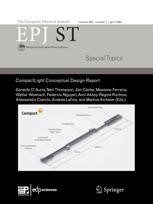A new era of research into laser-matter interactions
Studies of laser-matter interactions are an important and rapidly growing area of physics. This special issue of EPJ ST, edited by Sivarama Krishnan at the Indian Institute of Technology Madras and Marcel Mudrich at Aarhus University, Denmark, contains a set of 21 articles in this field, encompassing a broad range of experimental and theoretical approaches. The collection provides researchers with useful insights into this burgeoning area of science, and the exciting applications it may soon lead to.
New York | Heidelberg, 8 February 2022

In 2018, physicists Gérard Mourou and Donna Strickland shared a Nobel prize for their success in amplifying ultra-short laser pulses, without destroying the material required for amplification. Their achievement has now inspired a new era of studies into laser-matter interactions, in which intense, ultra-short light pulses at optical and infrared wavelengths play a central role. When the strengths of these light fields approach those of the extreme electric fields found within atoms, nanoparticles and condensed crystal lattices, they can induce highly nonlinear properties: meaning matter will respond disproportionately to any changes in the light inducing them.
When ionised in this way, materials can transform into plasmas with drastically altered optical properties. For physicists, an overarching challenge of future research in this area will be to deepen their understanding of these laser-induced plasmas. In addition, researchers are developing new ways to use them for novel applications: including biomedical imaging, laser-driven particle acceleration, and techniques for precisely etching or depositing microscopic patterns onto thin films.
Another key pillar of this work is the emission by matter of high-frequency harmonics contained in laser beams – enabling the study of physical dynamics over timescales of just billionths of a nanosecond. In doing this, physicists will need to use a combination of creative experimental methods and advanced new theoretical approaches. This collection of articles now draws together the efforts of both leading and upcoming researchers from institutions around the world, each studying a wide range of areas within this rich field of research.
All articles are available here and are freely accessible until 4 April 2022. For further information read the Editorial.
References: Krishnan, S., Mudrich, M. Intense laser matter interaction in atoms, finite systems and condensed media: recent experiments and theoretical advances. Eur. Phys. J. Spec. Top. 230, 3981–3988 (2021). https://doi.org/10.1140/epjs/s11734-021-00364-x
Further Information
For more information visit: www.epj.org
Services for Journalists
The full-text of the Editorial is available here.
Contact
Sabine Lehr | Springer | Physics Editorial Department
tel +49-6221-487-8336 | sabine.lehr@springer.com
